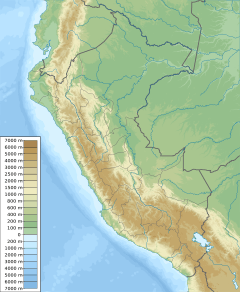Pikimachay facts for kids
| Location | Peru |
|---|---|
| Region | Ayacucho Region |
| Coordinates | 13°02′27″S 74°13′27″W / 13.04083°S 74.22417°W |
Piki Mach'ay is an ancient cave site in the Ayacucho Valley of Peru. Its name comes from the Quechua language. Piki means "flea" and mach'ay means "cave," so it's known as the "flea cave."
Archaeologists have found signs that people lived in Piki Mach'ay a very long time ago. Some studies suggest humans were there between 22,200 and 14,700 years ago. However, other experts think a more likely date is around 12,000 years BCE (Before Common Era).
Discovering Piki Mach'ay
The first archaeologist to explore Piki Mach'ay was Richard S. MacNeish. He looked for clues about early human life in the cave. Evidence found there suggests people lived in this area for a very long time.
Piki Mach'ay is part of a group of ancient sites. These sites are known as the Ayacucho complex. Another cave in this group is Jaya Mach'ay, which means "pepper cave."
Ancient Tools and Animals
Archaeologists found many interesting things inside Piki Mach'ay. These items are called artifacts. They include tools made from stone, like basalt and chert. There were also choppers and points for spears or arrows.
Bones of ancient animals were also discovered. These include bones from horses, camelids (like early llamas), and huge giant sloths. These findings show us what animals lived in Peru between 15,000 and 11,000 years BCE.
Early Farming and Food
Piki Mach'ay is important because it has some of the oldest plant remains found in Peru. One amazing discovery was an 11,000-year-old bottle gourd. This shows that people were using plants very early on.
Later layers of the cave show tools used for grinding food. These include fishtail point arrows, manos, and metates. These tools suggest that people started processing plants for food.
Before 3,000 years BCE, people in the Ayacucho Basin were growing several crops. These included amaranth, cotton, gourds, lucuma, quinoa, and squash. By 4,000 years BCE, they were also growing corn (Zea mays) and common beans. Chili remains found in the cave date from 5,500 to 4,300 years BCE.
The large number of guinea pig bones found suggests that these animals might have been tamed. Llamas may have also been domesticated by people between 4,300 and 2,800 years BCE. This shows how early people in Peru began farming and raising animals.
See also
 In Spanish: Piquimachay para niños
In Spanish: Piquimachay para niños


